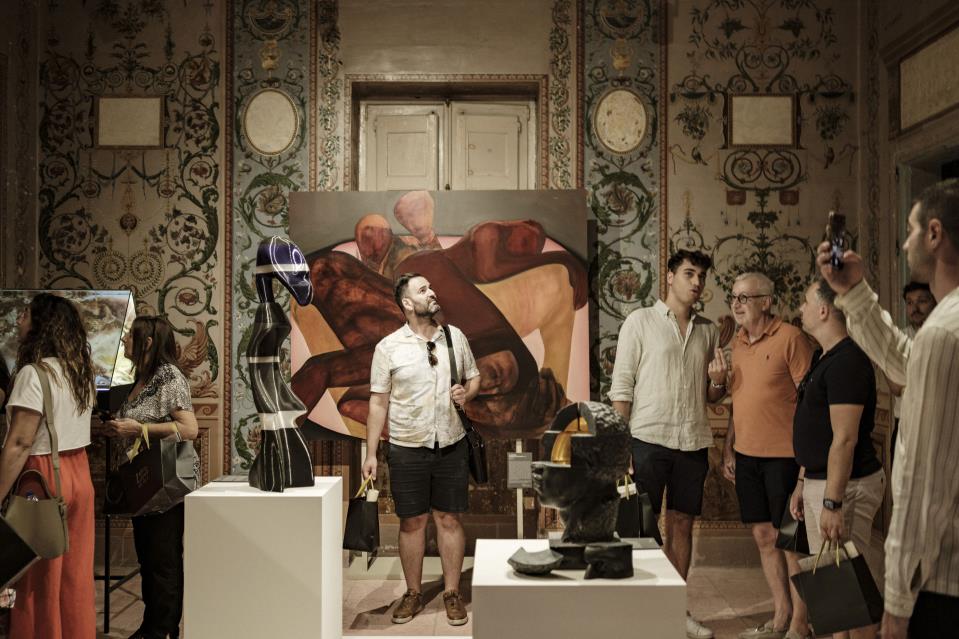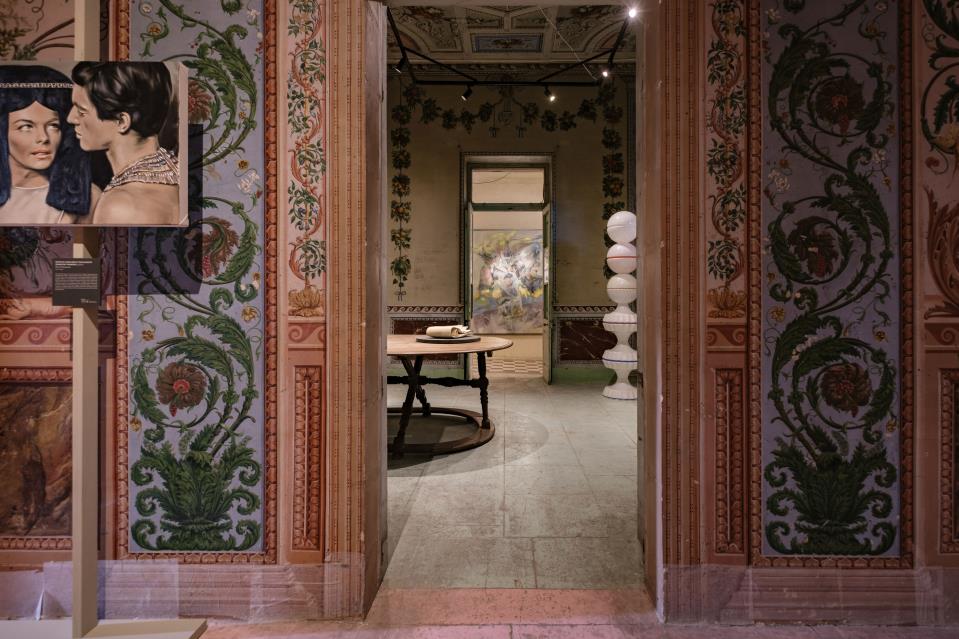Has Luginsland of Art been officially opened? Has it started functioning yet?
Currently, the villa is still under restoration. We had our initial opening last Spring during maltabiennale.art 2024. The idea for the initial opening was to share our work with the public. Before our project, the villa had been closed for many years. We didn't want to wait any longer, as we believe that this place deserves to be recognised. We also wanted to show the process of our work, not only the final outcome. In a project of this scale, there is so much happening that it would be a pity not to share it. During our opening days, the audience got a chance to see our restoration efforts and got insights about what we are exactly doing.

Exhibition ‘Space & Time’. Photo: Brian Grech
Can you tell us something about this fabulous building?
Villa Luginsland was founded in 1887 by Baron Maximilian Tucher von Simmelsdorf, who was a German consul in Malta. The baron was interested in art, astronomy and new technologies. You can see that building the villa was his passion project. He collaborated with local architect Francesco Zammit, and artist Giuseppe Calì. Calì's wall paintings make the interiors of the villa just breathtaking. The baron ran an open house in the villa, inviting such luminaries as Wilhelm II and King Edward VII, among others. For many years, the villa has remained untouched, until four years ago, when Omenaa Mensah, the founder of OmenaArt Foundation, decided to take on this ambitious project and bring the villa back to its former glory.

The interior of the LuginsLand of Art with polychrome paintings by Giuseppe Cali. Photo: Luginsland Limited
Can you tell us something about yourself and how you came to be in Malta?
I came to Malta to seek new challenges. I fell in love with this island and now I consider it to be my home. I was thrilled when I heard about LuginsLand of Art. I've known Omenaa Mensah for many years and I've always been in awe of her ideas. Working with Omenaa and helping her make her dream come true, has been an honour. Despite all the challenges that we encounter during the project, I truly love what I do. I believe that no matter the circumstances, you can always find a way. Working on a project of this scale, you need to remain very open-minded and creative. I've learnt a lot about myself and I can't wait to see the final effect of our efforts.

Omenaa Mensah, right, with the director of LuginsLand of Art, Joanna Popiol. Photo: Kurt Paris
What has been going on so far?
As I mentioned, last Spring, we opened our doors for the first time. We organised a site-specific exhibition Space & Time, curated by Boris Kudlicka, featuring Maltese and Polish artists. The OmenaArt Foundation organised a thematic pavilion at maltabiennale.art 2024, and our events at the villa were correlated to the biennale. We also launched an educational programme with five discussion panels with international art specialists, historians, architects and art conservators. We invited the local community to learn more about the villa and our work. What is more, last September, together with the OmenaArt Foundation we hosted four Polish artists as part of our new initiative - the International Art Residency Programme. We want to support emerging artists in their creative development. The residency programme allows them to boost their creativity in the beautiful Mediterranean surroundings. So far, all our events have been well received by the local community. We constantly get requests for visits. Unfortunately, due to the restoration work going on we cannot accept visitors at the moment. But we encourage everyone to follow our work. It's a long process but when we open the doors to the public again, it will definitely be worth it.

Inside Villa Lugisland: In 1996, the Lugisland estate was declared a Grade I historic property. Photos: Brian Grech
What plans do you have for the future?
Part of the villa will be transformed into an art centre, a new creative hub in Malta. We want to create a space for exhibitions, art events and international artistic discourse. We will also continue our Art Residency programme to support more artists and give them an opportunity for creative exploration. Currently, we are mostly focused on the technicalities of the restoration process. There is a lot of work still to be done but it's exciting to see how all of this is shaping into something truly special.

Restoration works at the Villa. Photo: Jacek Poremba
ABOUT VILLA LUGINSLAND
This architectural gem was designed by a local architect Francesco Zammit, who was entrusted with the creation of the project by the baron, and used a style that was a combination of contemporary trends containing elements of Italian, French and British architecture. Surprisingly, the style of Villa Luginsland does not correspond with any other residential property projects by Zammit, in fact, it is significantly different and exceptional. This observation may indicate that the baron was involved in the designing process himself. The residence contains numerous spatial reference points creating a network of intersecting axial symmetries. The geometry of the building and craftily designed optical concept might be connected to baron’s intricate knowledge of not only astrology, mathematics and physics, but also the masonic philosophy which promotes spiritual development and alliance of religions, nationalities and opinions.
Interior
The interior of the villa features notable polychrome paintings by Giuseppe Calì, a prominent Maltese artist from the late 19th and early 20th centuries. These wall paintings showcase Calì’s expertise, characterised by intricate detail, vibrant colours, and skillful use of the light and shadow to create depth. By incorporating polychrome on the ceiling, Calì achieved optical illusion, making the rooms appear larger than they actually are. What’s interesting is that paintings in different rooms of the villa exhibit variations in style, suggesting the possibility of involvement by another artist. However, currently we don’t have evidence supporting this argument.
